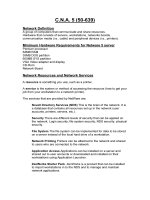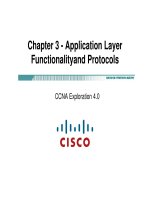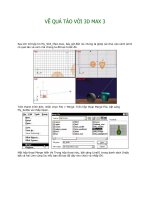CCNA Exploration Semester 1-Chapter 5 ppt
Bạn đang xem bản rút gọn của tài liệu. Xem và tải ngay bản đầy đủ của tài liệu tại đây (965.4 KB, 49 trang )
OSI network layer
CCNA Exploration Semester 1
1
17-Jul-12 CCNA Exploration Semester 1
CCNA Exploration Semester 1
Chapter 5
OSI network layer
OSI model layer 3
TCP/IP model Internet layer
Application
HTTP, FTP,
2
17-Jul-12 CCNA Exploration Semester 1
Application
Presentation
Session
Transport
Network
Data link
Physical
Application
Transport
Internet
Network Access
TCP, UDP
IP
Ethernet,
WAN
technologies
HTTP, FTP,
TFTP, SMTP
etc
Segment
Packet
Frame
Bits
Data
stream
Network layer topics
IP version 4 – the most common layer 3
routed protocol
Dividing hosts into groups – why and how
Routing
–
sending packets the right way
3
17-Jul-12 CCNA Exploration Semester 1
Routing
–
sending packets the right way
Routing – how routers learn routes
IP addressing – in chapter 6
Purpose of layer 3
Decide how to get the data from source to
destination, then route it.
4
17-Jul-12 CCNA Exploration Semester 1
Layer 3 protocol
A layer 3 protocol such as IP version 4 must:
Provide an addressing scheme to identify
networks and individual hosts
Encapsulate
a segment from layer 4 into a
5
17-Jul-12 CCNA Exploration Semester 1
Encapsulate
a segment from layer 4 into a
packet and include addresses
Direct the packet across one or many
networks to the destination host
Decapsulate (remove the packet header) and
give the segment to layer 4.
Network Layer – Communication from
Host to Host
Layer 3 uses four basic processes:
1. Addressing
2. Encapsulation
3. Routing: Intermediary devices that connect the networks
are called routers. The role of the router is to select
6
17-Jul-12 CCNA Exploration Semester 1
are called routers. The role of the router is to select
paths for and direct packets toward their destination.
This process is known as routing.
4. Decapsulation
Network layer protocols
Internet Protocol version 4 (IPv4) – the most
common
Internet Protocol version 6 (IPv6) – designed
to replace version 4 eventually
7
17-Jul-12 CCNA Exploration Semester 1
to replace version 4 eventually
Novell Internetwork Packet Exchange (IPX)
AppleTalk
Connectionless Network Service
(CLNS/DECNet)
The roles of IPv4 protocol
IPv4 is currently the most widely-used version of IP
The Internet Protocol was designed as a protocol
with low overhead. It provides only the functions that
are necessary to deliver a packet from a source to a
8
17-Jul-12 CCNA Exploration Semester 1
destination over an interconnected system of
networks.
The protocol was not designed to track and manage
the flow of packets. These functions are performed
by other protocols in other layers.
IP characteristics
Designed with low overhead for speed – it
does only what it needs to do.
Connectionless – does not set up connection
with destination before sending packet.
9
17-Jul-12 CCNA Exploration Semester 1
with destination before sending packet.
Best effort (unreliable) no guarantee of safe
delivery, no checking or resending.
Independent of media, but does need to
know maximum packet size.
Connectionless
10
17-Jul-12 CCNA Exploration Semester 1
IP does not notify the destination host.
Which layer 4 protocol on the sending host will establish a
connection?
TCP: A connection-oriented protocol.
Which layer 4 protocol on the sending host will not establish a
connection?
UDP: A connectionless protocol.
Best Effort Service (unreliable)
11
17-Jul-12 CCNA Exploration Semester 1
Layer 3 (IP)
Speed over reliability
Unreliable: Does not have the capability or responsibility to
manage, and recover from, undelivered or corrupt packets.
Who does?
TCP at the end-to-end hosts
Media Independent
12
17-Jul-12 CCNA Exploration Semester 1
Responsibility of the OSI Data Link layer to take an IP packet and
prepare it for transmission over the communications medium.
Transport of IP packets is not limited to any particular medium.
May need to fragment the packet if it is too many bits (later).
Network layer encapsulation
Segment from transport layer
Packet header added to make
13
17-Jul-12 CCNA Exploration Semester 1
Packet header added to make
IP packet
Sent to data link layer for
further encapsulation into
frame
IPv4 packet header fields
IP address of source
host, needed so reply
can be sent.
IP address of destination
host, needed so routers
can find route.
14
17-Jul-12 CCNA Exploration Semester 1
IPv4 packet header fields
Reduced by 1 at each
router. Packet dropped if
it goes to 0.
TCP or UDP used in
Transport layer.
15
17-Jul-12 CCNA Exploration Semester 1
Protocol field enables the Network layer to pass
the data to the appropriate upper-layer protocol.
Example values are:
01 ICMP
06 TCP
17 UDP
16
17-Jul-12 CCNA Exploration Semester 1
17 UDP
Sending hosts generates the value for TTL.
Common operating system TTL values are:
UNIX: 255
Linux: 64 or 255 depending upon vendor and version
Microsoft Windows 95: 32
Microsoft Vista: 128
IPv4 packet header fields
Priority for QoS. E.g.
voice data has higher
priority than e-mail.
For checking if header has
been corrupted.
17
17-Jul-12 CCNA Exploration Semester 1
IPv4 packet header fields
Shows if packet has
been fragmented or
must not be fragmented.
If router has to split a
packet, this gives order for
putting pieces together.
18
17-Jul-12 CCNA Exploration Semester 1
IP Fragmentation
Data = 1480 bytesIP
Data = 500IP
Data = 480IP
IP Packet
Fragments
Original IP
Packet
IP Header = 20 bytes
Data = 500IP
19
17-Jul-12 CCNA Exploration Semester 1
A router may have to fragment a packet when forwarding it from one
medium to another medium that has a smaller MTU.
If Don’t Fragment flag set, it will not fragment packet, but discard it.
Data = 520L2 L2
This packet is too big to
go over my serial link all
at once. I need to break it
into smaller fragments
Data = 520L2 L2
Data = 500L2 L2
Network Layer Fields
3 bits(R, DF. MF)
– R(reserved): set to 0.
– DF(Don’t fragment):
20
17-Jul-12 CCNA Exploration Semester 1
• 0: Fragment if necessary.
• 1: Do not fragment.
– MF(More fragment):
• 0: This is the last fragment.
• 1: More fragment follow this fragment
IPv4 packet header fields
Version 4.
Length of whole packet.Header
length.
21
17-Jul-12 CCNA Exploration Semester 1
Splitting up networks
Fully switched network, each device has its own
bandwidth. You could have hundreds of computers.
Why split it up?
22
17-Jul-12 CCNA Exploration Semester 1
Too large to manage efficiently
Too much broadcast traffic - congestion
Too many addresses for switches to remember
Lack of security
How to split the network
Geographically – different sites
Purpose – what software and shared
resources do people use? How much
bandwidth do they use?
23
17-Jul-12 CCNA Exploration Semester 1
bandwidth do they use?
Ownership – different companies or
departments in a company, security
requirements
Broadcast domain ? - Performance
A broadcast is a message sent from one host to all other
hosts on the network.
Managing the size of broadcast domains by dividing a
network into subnets or replace switch by router
24
17-Jul-12 CCNA Exploration Semester 1
Use a router
Limits broadcasts
Can provide security
Addressing scheme
based on networks
-
25
17-Jul-12 CCNA Exploration Semester 1
based on networks
-
hierarchical









